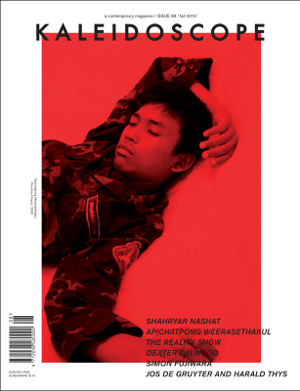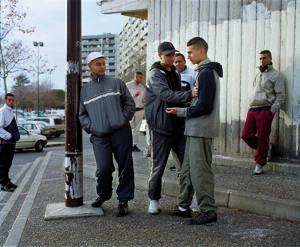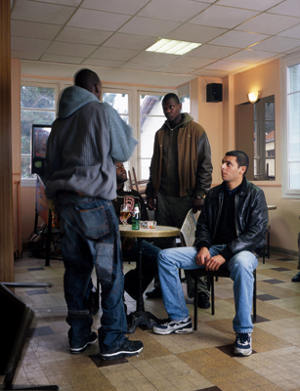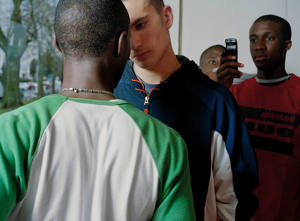L'edicola digitale delle riviste italiane di arte e cultura contemporanea
Kaleidoscope Anno 2 Numero 8 settembre - ottobre 2010
Mohamed Bourouissa
Quinn Latimer

a contemporary magazine

MAIN THEME: THE REALITY SHOW: The Action of Seeing by Tina Dicarlo & Khadija Carroll La; Mohamed Bourouissa by Quinn Latimer; Complacency Kills by Joe Sacco; Nikons and Icons by David Levi Strauss; Massimiliano and Gianluca De Serio by Michele D’Aurizio & Eva Fabbris
MONO: DEXTER DALWOOD: When History Collapses into the Present by David Anfam; The Space of Enchantment by Martin Herbert; Sharpenings by Cherry Smyth.
COLUMNS:
PIONEERS: Lourdes Castro by Simone Menegoi; FUTURA: Simon Fujiwara by Hans Ulrich Obrist;
MAPPING THE STUDIO: Pawel Althamer in Warsaw by Luca Cerizza; VIA À VIS: Jos De Gruyter and Harald Thys by Elena Filipovic;
CRITICAL SPACE: The Politics of Friendship by Markus Miessen;
ON EXHIBITION: Ce qui arrive by Paola Nicolin;
LAST QUESTION by Philippe Parreno.
Torbjørn Rødland
Hanne Mugaas
n. 22 autunno -inverno 2014
John Armleder
Andrea Bellini
n. 21 estate 2014
Voiceover: Under the skin
Shama Khanna
n. 20 inverno 2013-2014
Yang Fudong
Davide Quadrio e Noah Cowan
n. 19 autunno 2013
Massimiliano Gioni
Francesco Manacorda
n. 18 estate 2013
John Currin
Catherine Wood
n. 17 inverno 2012-2013

from the series “Périphéries,” 2007
Courtesy: the artist and Galerie Les filles du calvaire, Paris

from the series “Périphéries,” 2007
Courtesy: the artist and Galerie Les filles du calvaire, Paris

from the series “Périphéries,” 2006
Courtesy: the artist and Galerie Les filles du calvaire, Paris
Though skillfully staged and indebted to classical painting, MOHAMED BOUROUISSA ’s pictures of the periphery are eloquent statements on the ethical fallout of photojournalism, calling into question the problematic power relations encoded in the photographic medium.
The taut and tensile line between documentary and fiction is one of the defining critical positions and themes of postmodern literature. See the plethora of recent novels in which the protagonist neatly shares a name with his or her author, or the more allusive Sebaldian mode, in which personal and political histories, both invented and real, collude to create the very truth of the text. Such approaches and the suggestive spaces conjured by these novels in which truth and art slide as seamlessly into each other as water, or collide as jarringly as shifting seismic plates, have been less exploited in contemporary art practice, where artifice is a given—and where the question “But is this true?” almost never arises from the audience. Almost. Mohamed Bourouissa’s potent photographs are one of the current exceptions.
The Algerian-born, Paris-based photographer’s lush and elusive color images feature the stuff of standard photojournalism: impoverished, stylish young African and Arab men and women (immigrants or the children of immigrants) living in suburban housing projects on the outskirts of a major metropolis—in this case, Paris, with its banlieues, in which the artist himself grew up, lying beyond the ring of the city’s beltway, péripherique. Yet there is something about the images that does not quite align with photojournalistic mores and methods: one cannot imagine them coming from the pages of a newspaper or accompanying a magazine article on disenfranchised youth. The photographs are too classically composed, too richly hued, too ambiguously evocative, too shadow-strewn. Most of all, they are too still. They evince the halting, motionless elegance of classical painting, in which gestures are frozen and isolated, momentarily mirroring the viewer who suddenly stops in private contemplation in front of some canvas. Simultaneously, the photographs are laden with lyrical strokes of the dramatic lighting that characterizes film stills. This romantic, sometimes overwrought cinematography leads the viewer’s eye on a tour of each image’s corners: Here, the photograph seems to say, is the protagonist, his handsome, inscrutable face lit as if by a strobe. And here, in the background, are the minor characters, a chorus of sorts, standing in dusky shadow. Notice how their faces are partially, if meaningfully, occluded. Notice how their intentions are secreted.
Such implicit (and perhaps ironic) stage directions point to the inherent theatricality of Bourouissa’s photographs and to the methods that produce them. Many of their compositions are gleaned from or inspired by paintings by Caravaggio, Delacroix, Géricault and Poussin; like a painter, the artist sketches out his images on paper before realizing them on film. The photographs’ locations, meanwhile, are scouted in much the same way a film location might be. And their subjects are assembled via a “fixer”—a name for a career usually spoken of in tales of intrepid photojournalists in unfamiliar war zones—who assists Bourouissa in becoming acquainted with a neighborhood or housing project and its resident youth. The complexity of this process, and the way it combines the methodologies of painting, film and photojournalism, produces images that fairly shout their interest in borders—formal, conceptual, economic, racial, sexual and architectural— as well as both the preconceptions and porosity those borders are inclined to involve.
Despite the explicitness of Bourouissa’s concerns, however, the images evince, in addition to stillness, a thoroughly disquieting silence. See the couple—a boxer and his trainer—of La fenetre (The Window) (2005), posed in a strange duet in front of a lime-green wall. Standing close together, their dark, shaved heads gleam in the light from the titular window just off-camera. Their hands rise in a kind of unison, their bodies each a loose mirror of the other, but for the tattooed phoenix that rises in dissembling flames across the boxer’s bare, muscled back. Or see Le téléphone (2006), which reprises this standoff but in its opposite form. Instead of closeness and paternity, we find aggression (and perhaps desire) in two young men facing off, their sports shirts nearly matching, their skin color contrasting. Onlookers stand in the back of the frame, their wide eyes on the camera phone that one young man enigmatically holds up, capturing a confrontation that boasts fear but also a not-so latent homoeroticism. If women appear in some of these tableaux, they are simply sexual or dramatic foils to the young men Bourouissa is so interested in delineating. So it is that a skeptical girl with a ponytail grasps the arm of the young man with a clenched fist who leans in menacingly at her in Le poing (The Fist) (2006). Or that a lithe Asian woman leans back on a bed in La main (The Hand) (2006), one man’s hand intently resting on her stomach, another young man drinking beer in the shadows behind.
The cryptic and unnerving pathos of such images—all of which comprise the series “Périphéries,” shown at Yossi Milo Gallery in New York this past spring—is conjured by Bourouissa’s carefully orchestrated confrontations, exchanges and gestures. The narratives that emerge, meanwhile, come from the age of the subjects and the color of their skin, the clean style and definitive labels of their clothing, attending signifiers of poverty like pit bulls, burnt-out cars and drab architectural settings—interior and exterior—that act as both stage and vice for their ambiguous actors. In his regard for the architecture of disenfranchisement as well as those subject to and sheltered by it, Bourouissa’s oeuvre is somewhat unique. In contemporary Western fine art photography, artists who concern themselves with society’s fringes or the ruins of modernism are the most likely to aim their cameras at the bleak, concrete slabs of architecture—emptied of its inhabitants—that symbolize it. To take stock of the residents that actually live there is perhaps too complicated, too sincere and too pointedly political for the many contemporary photographers who show in galleries rather than the pages of newspapers and news magazines.
But Bourouissa does not have such qualms, and his work is an unabashedly political project. For one, he grew up in the same neighborhoods, so the pressure to represent the other with authenticity and without perpetrating a kind of (post-) colonialist exploitation does not intimidate him. Furthermore, his project is based on the very idea of inclusion. As he has noted when talking about his upbringing in the banlieues, “[N]obody captured our youth and identity. That’s why I took up the camera.” To that end—and unlike many other current young artists with photographic tendencies, who look to the Pictures Generation for their cues Bourouissa found his early inspiration in the work of American photographer Jamel Shabazz, who joyfully and critically documented young, black street culture in New York in the 1980s. More recently, much has been made of Bourouissa’s kinship to Jeff Wall, not only because of their obvious shared mode of staging their pictures with the collaboration of their subjects and the fraught, cinematic, suburban melancholy of their sensibility, but because of their debt to classical painting and its compositional scores.
However, it is perhaps more interesting to look at Bourouissa’s work in light of the renewed discourse in the West on documentary pho photography, specifically photojournalism done by photographers in the midst of war or violence. Since the terrible events of 9/11 and the tragic wars that followed, the advent of photographers “embedded” within armies, and the overwhelming rise of digital photography and amateur photo documentation, issues of censorship, propaganda, exploitation and sensationalism have become more heavily debated by photography critics, editors and artists. Accordingly, a quarter of a century after the publication of her seminal collection of essays On Photography, Susan Sontag published a follow-up treatise on the photography of suffering in our media-saturated age, entitled Regarding the Pain of Others (2003). It broaches the ethical issues of power, entitlement and knowledge that photographs seemingly grant both their makers and their audience— issues that she first discussed in her 1977 volume. Although Bourouissa’s staged work does not take place in the war zones that Sontag discusses in her later volume, his photographs of contemporary ghettoized youth (and the moral positions such images tease out of their viewers) are directly related to the ethical fallout of photojournalism that the writer explores. Sontag’s astute reflections on the power of the image—whether staged or “documentary”—in her earlier book, meanwhile, remain astonishingly relevant to Bourouissa’s provocative boundary-blurring, and the expectations and preconceptions of the audience that he so deftly subverts and critiques.
“[Photographs] are a grammar and, even more importantly, an ethics of seeing. Finally, the most grandiose result of the photographic enterprise is to give us the sense that we can hold the whole world in our heads—as an anthology of images,” Sontag famously wrote in On Photography. “To photograph is to appropriate the thing photographed. It means putting oneself into a certain relation to the world that feels like knowledge—and, therefore, like power.” Her assertion underlies Bourouissa’s own more succinct declaration: “I deal with the problematic of power relations and I raise the question of the mechanics of power.” One might ask how he does this by staging images in which impoverished immigrant youth box, drink, argue and loiter—that is to say, images that might simply reinforce preconceived and conservative ideas about such populations.
But it is exactly the artist’s choice to “stage” such scenes, thereby divesting them of their fervid sensationalism and their use as material “proof” to support a larger societal or political narrative, that makes Bourouissa’s point about power relations. The ambiguity of his images makes it impossible to “appropriate the thing photographed,” to again quote Sontag, as the viewer is never quite sure of what “the thing” is. Are his images of leaping pit bulls and aggressive gangs of young men simply aping illustrations of photojournalistic clichés? Are they comments on the racial and economic exclusions of European art history? Are they celebrations of agency and creativity in a society only documented in times of turmoil and violence?
To this last question, one might look no further than the thousands of photojournalistic images that spilled out of these very Parisian ghettolike suburbs during the infamous riots in the fall of 2005, filling international newspapers with images of looting, burning cars and angry teenagers throwing rocks at riot police. The unrest, which, in another cliché, began in Clichy-sous-Bois after two teenagers died there in police custody, spread to poor housing complexes elsewhere outside Paris, and culminated in the French government declaring a state of emergency for approximately three months. At roughly the same time, Bourouissa was taking his own images in these same neighborhoods, images in which stillness, silence and elegance stood in stark contrast to the antic and violent images in the daily papers, even while the protagonists looked very much the same. “What I seek is the tenth of a second, very fleeting, where tension is at its peak,” the photographer has allowed. Yet he is well aware that “conflict does not necessarily read the voltage.” Or, as he puts it, in a comment that would do as a caption for any of his defiantly ambiguous and deftly authoritative images, “Anything can happen, as nothing can happen.”
QUINN LATIMER is an American poet and critic based in Basel, Switzerland. Her poems have been featured in Boston Review, The Paris Review and Muthafucka, among other journals, and her critical writing appears in Art in America, Artforum, ArtReview, Bookforum, and frieze. Her first book, a collection of poems titled Rumored Animals, recently won the 2010 American Poetry Journal Book Prize, and will be published in the summer of 2011.


